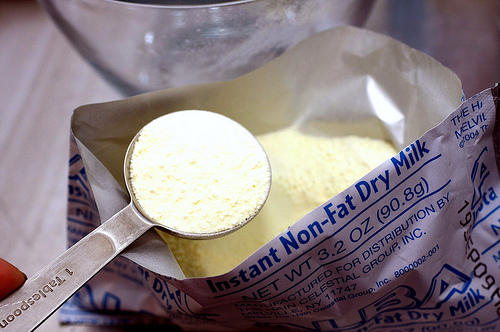| Condensed milk |  |
| Powdered milk |  |
Condensed milk
 Production Raw milk is clarified and standardised, and then is heated to 85-90°C for several seconds. This heating destroys some microorganisms, decreases fat separation and inhibits oxidation. Some water is evaporated from the milk and sugar is added to approximately 45%. This sugar is what extends the shelf life of sweetened condensed milk. Sucrose increases the liquid's osmotic pressure, which prevents microorganism growth. The sweetened evaporated milk is cooled and lactose crystallization is induced. Current use In parts of Asia, sweetened condensed milk is the preferred milk to be added to coffee or tea. In New Orleans, sweetened condensed milk is commonly used as a topping on chocolate. | |
Powdered milk
 Powdered milk is frequently used in the manufacture of infant formula, confectionery such as chocolate and caramel candy, and in recipes for baked goods where adding liquid milk would render the product too thin. Powdered milk is also widely used in various sweets such as the famous Asian milk balls known as Rasgulla, Barfi and popular Asian sweet delicacy (sprinkled with desiccated coconut) known as Chum chum (made with skim milk powder). Nutritional value Milk powders contain all twenty-one standard amino acids, the building blocks of proteins, and are high in soluble vitamins and minerals.[6] According to ________,[7] the typical average amounts of major nutrients in the unreconstituted nonfat dry milk are (by weight) 36% protein, 52% carbohydrates (predominantly lactose), calcium 1.3%, potassium 1.8%. Whole milk powder, on the other hand, contains on average 25-27% protein, 36-38% carbohydrates, 26-40% fat, and 5-7% ash (minerals). However, inappropriate storage conditions such as high relative humidity and high ambient temperature can significantly degrade the nutritive value of milk powder.[8] |
